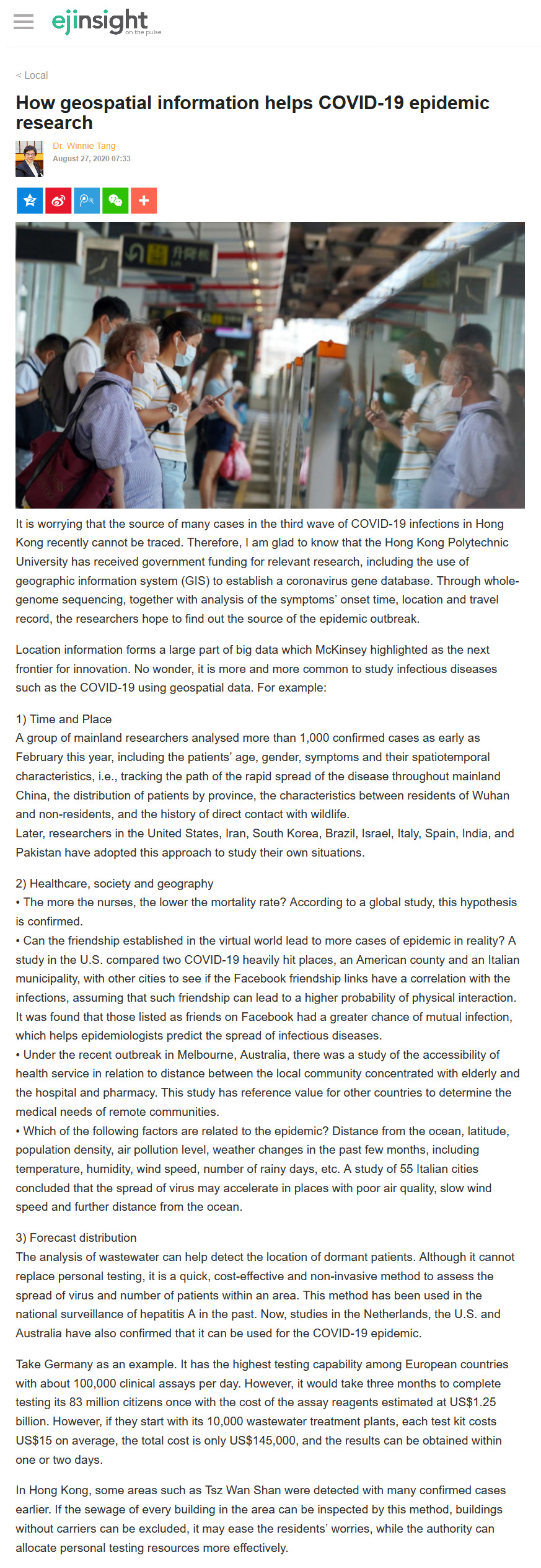網上版請按此

How geospatial information helps COVID-19 epidemic research
It is worrying that the source of many cases in the third wave of COVID-19 infections in Hong Kong recently cannot be traced. Therefore, I am glad to know that the Hong Kong Polytechnic University has received government funding for relevant research, including the use of geographic information system (GIS) to establish a coronavirus gene database. Through whole-genome sequencing, together with analysis of the symptoms’ onset time, location and travel record, the researchers hope to find out the source of the epidemic outbreak.
Location information forms a large part of big data which McKinsey highlighted as the next frontier for innovation. No wonder, it is more and more common to study infectious diseases such as the COVID-19 using geospatial data. For example:
1) Time and Place
A group of mainland researchers analysed more than 1,000 confirmed cases as early as February this year, including the patients’ age, gender, symptoms and their spatiotemporal characteristics, i.e., tracking the path of the rapid spread of the disease throughout mainland China, the distribution of patients by province, the characteristics between residents of Wuhan and non-residents, and the history of direct contact with wildlife.
Later, researchers in the United States, Iran, South Korea, Brazil, Israel, Italy, Spain, India, and Pakistan have adopted this approach to study their own situations.
2) Healthcare, society and geography
• The more the nurses, the lower the mortality rate? According to a global study, this hypothesis is confirmed.
• Can the friendship established in the virtual world lead to more cases of epidemic in reality? A study in the U.S. compared two COVID-19 heavily hit places, an American county and an Italian municipality, with other cities to see if the Facebook friendship links have a correlation with the infections, assuming that such friendship can lead to a higher probability of physical interaction. It was found that those listed as friends on Facebook had a greater chance of mutual infection, which helps epidemiologists predict the spread of infectious diseases.
• Under the recent outbreak in Melbourne, Australia, there was a study of the accessibility of health service in relation to distance between the local community concentrated with elderly and the hospital and pharmacy. This study has reference value for other countries to determine the medical needs of remote communities.
• Which of the following factors are related to the epidemic? Distance from the ocean, latitude, population density, air pollution level, weather changes in the past few months, including temperature, humidity, wind speed, number of rainy days, etc. A study of 55 Italian cities concluded that the spread of virus may accelerate in places with poor air quality, slow wind speed and further distance from the ocean.
3) Forecast distribution
The analysis of wastewater can help detect the location of dormant patients. Although it cannot replace personal testing, it is a quick, cost-effective and non-invasive method to assess the spread of virus and number of patients within an area. This method has been used in the national surveillance of hepatitis A in the past. Now, studies in the Netherlands, the U.S. and Australia have also confirmed that it can be used for the COVID-19 epidemic.
Take Germany as an example. It has the highest testing capability among European countries with about 100,000 clinical assays per day. However, it would take three months to complete testing its 83 million citizens once with the cost of the assay reagents estimated at US$1.25 billion. However, if they start with its 10,000 wastewater treatment plants, each test kit costs US$15 on average, the total cost is only US$145,000, and the results can be obtained within one or two days.
In Hong Kong, some areas such as Tsz Wan Shan were detected with many confirmed cases earlier. If the sewage of every building in the area can be inspected by this method, buildings without carriers can be excluded, it may ease the residents’ worries, while the authority can allocate personal testing resources more effectively.
Dr. Winnie Tang
Adjunct Professor, Department of Computer Science, Faculty of Engineering; Department of Geography, Faculty of Social Sciences and Faculty of Architecture, The University of Hong Kong